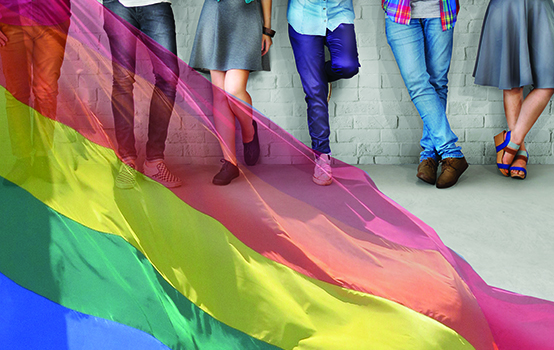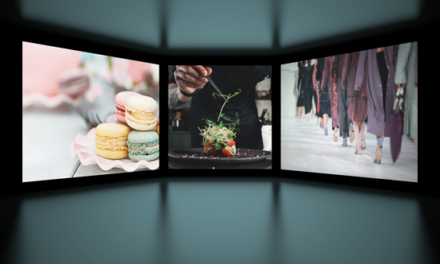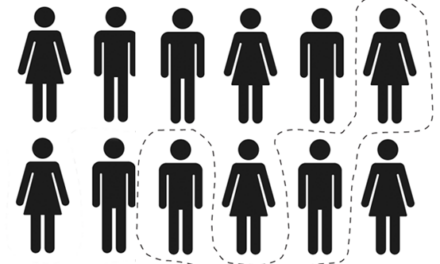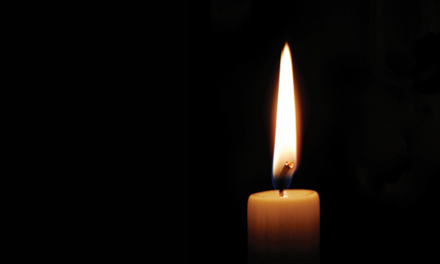An inclusive curriculum moves beyond separate lessons on LGBTQ+ heroes to incorporate their perspectives throughout the course.
When you think about places that aren’t accepting of nontraditional gender norms and identities, the first examples that come to mind might be places of worship, the workplace, the doctor’s office, or even some families. But what about the classroom?
As Robert McGarry (2013) previously explained in Kappan, the avoidance or exclusion of individuals representing certain groups, including LGBTQ+ people, is the most basic form of bias in school curriculum. Just 9% of 8,574 student respondents to a 2013 survey reported being in classes where LGBTQ+ topics were taught (Kosciw et al., 2014). And 37% of respondents to a 2018 Harris Poll reported that they would be uncomfortable learning that their child had a lesson involving LGBTQ+ history (Harris Poll, 2018).
This “missing discourse” about gender and sexuality and, in turn, those who identify outside the realm of traditional heterosexuality is problematic (Crocco, 2001). LGBTQ+ people and issues are embedded in the American experience. Nearly 9 in 10 Americans know someone who is gay or lesbian; 3 in 10 know someone who is transgender (Pew Research Center, 2016). Additionally, changes in policy and law across the country are legitimizing and supporting LGBTQ+ individuals (e.g., the legalization of same-sex marriage and adoption by same-sex couples and the military’s inclusion of openly gay and lesbian recruits). Excluding LGBTQ+ people and issues from the curriculum disregards this reality and denies young people a view into themselves and into their world.
Although at least seven states have laws prohibiting LGBTQ+-inclusive curriculum, many policy makers, educators, and school systems are embracing LGBTQ+ individuals and issues in the classroom. California stands out for its efforts in this area. This fall, K-12 classrooms in the state began using textbooks that included LGBTQ+ content, and for the last three years, a San Francisco high school has offered an LGBTQ Studies course, likely the first in the country and a pilot for others in the district. Though far from typical, these efforts present an opportunity to see how an inclusive LGBTQ+ curriculum is playing out in schools, and they offer guidance on how best to encourage an understanding and acceptance of gender and sexuality among students.
California’s FAIR Act
In 2011, after a spike in suicides among LGBTQ+ youth and emerging research on the benefits of a curriculum that includes LGBTQ+ topics (e.g., Bird, Kuhns, & Garofalo, 2012), Governor Jerry Brown signed into California law the Fair, Accurate, Inclusive, and Respectful (FAIR) Education Act. FAIR expanded the state’s education code to require that the roles and contributions of LGBTQ+ individuals and people with disabilities be part of history and social studies instruction. Five years later, after multiple challenges to the law, the California State Board of Education approved a statewide social studies curriculum framework that included among required topics the evolution of gay rights and the contributions of lesbian and gay figures in history. Selection of framework-compliant textbooks followed, with the board formally approving 10 textbooks in November 2017.
During the textbook-selection process, the board came up against several concerns from textbook publishers. When two books from Houghton Mifflin Harcourt were rejected for lacking adequate LGBTQ+ content, a representative for the publisher explained that although LGBTQ+ people are “central to both United States history and culture, . . . the terms lesbian, gay, bisexual, transgender, and queer are contemporary terms that may not map well on past lives and experiences” (Harrington, 2017). Similarly, McGraw-Hill initially rejected a request to refer to poet Langston Hughes as gay because, according to the textbook publisher, “there is no definitive evidence or scholarly consensus [that] he was gay” (Harrington, 2017). However, in the end, the publisher added that Hughes “was a famous gay African American poet.” Supplemental instruction for teachers now also includes LGBTQ+ individuals and issues. For instance, McGraw-Hill added the following to a teacher’s edition: “Though [Walt] Whitman never publicly addressed his sexuality, his poetry, letters, and journals suggest that Whitman would identify as gay if he were alive today. . . . Whitman shared a decades-long romantic friendship with bus conductor Peter Doyle. Though the two never lived together, Doyle was Whitman’s muse” (Harrington, 2017). Other historic figures, including Emily Dickinson, Ralph Waldo Emerson, Nathaniel Hawthorne, and President James Buchanan, are now included in textbooks as historical figures who are widely considered by historians to have been LGBTQ+.
Look for historical figures already included in the curriculum or standards who were known to be or considered to have been LGBTQ+.
LGBTQ Studies in one high school classroom
The new textbooks are just one way that California schools are incorporating content about LGBTQ+ people and issues in the K–12 curriculum. An LGBTQ Studies course at the Ruth Asawa San Francisco School of the Arts (SOTA) offers an example of another approach. The course was conceived, developed, and initially taught by Lyndsey Schlax, an expert teacher with a decade of classroom experience. Schlax, now an assistant principal at a high school outside San Francisco, championed the course from its fall 2015 inaugural semester through spring 2018.
About 26 students typically enroll in the class, and the percentage of students in the course who self-identified as LGBTQ+ in spring 2016 (Moorhead, 2018) mapped closely to the school’s overall percentage of LGBTQ+ students, about 16% (10% higher than the district’s average). As the backdrop to the class, SOTA offers an academic curriculum along with an arts-training program to approximately 650 students: 27% of students are socioeconomically disadvantaged, 6% are English learners, and total nonwhite enrollment is 60% (Coghlan, Rowley, & Trusso, 2016).
In developing the course, Schlax wanted to highlight the crucial contributions of LGBTQ+ individuals to American history. “It’s really important for kids to see themselves in their education,” she said. “There has to be some point in everybody’s education where they know that a gay person grows up to be an adult and can do important historical and science-related work. Or that kid who is trans can know that there is a future — that it’s real. If students aren’t seeing that in school, then I’m not sure where they do.” This approach meant not just covering such events as the Stonewall Riots and the legalization of same-sex marriage, but also exploring how gay rights and identity were related to other historical movements and events. Several students noted that course content complemented curriculum in their other classes. “A lot of the events that we covered, like the Red Scare, the Gay Scare, the Lavender Scare, were kind of parallel to other major events that we learned about in history class,” a student explained. “I hadn’t heard about those — they were kind of foreshadowed by the non-LGBTQ events. But they’re equally important.” Students credited the course with helping them reconsider their perspectives on both current events and long-standing historical tropes.
In recognition of the course’s educational value, district officials considered the LGBTQ+ elective a prototype for other schools in the area, and both the University of California and the California State System now allow it as one of the elective courses students may take to qualify for admission.
Excluding LGBTQ+ people and issues from the curriculum denies young people a view into themselves and into their world.
Banks’ tiers of integration
The course follows James Banks’ (2010) flexible, four-tiered approach to integrating multicultural content into curriculum. This approach, which came as a response to what Banks called a “strong assimilationist ideology” among U.S. educators who struggle to “think differently about how U.S. society and culture developed” (p. 236), offers educators steps for implementing multicultural content as individual courses and programs or, ideally, across the curriculum. The four tiers can be implemented in order of level or through a concurrent mix of levels:
- Level 1: Contributions. Focuses on heroes, holidays, and discrete cultural elements.
- Level 2: Additive. Adds content, concepts, themes, and perspectives to the curriculum without changing its structure.
- Level 3: Transformation. Alters the structure of the curriculum to encourage students to view concepts, issues, events, and themes from multiple perspectives.
- Level 4: Social Action. Encourages students to make decisions about important social issues and take actions to help address them.
Practitioners including LGBTQ+ content in curricula for the first time might begin with Banks’ initial tier and gradually move to the final one, or they may reserve the lower tiers for earlier grades and opt for the higher tiers for more advanced grades. Another option is to identify content areas (e.g., literature, history, or social studies) for piloting the higher approaches, allowing for gradual structural changes in curriculum. A full-scale rollout across a school or district could follow. Educators can also consider where LGBTQ+ content “most authentically appears in the curriculum” and implement Banks’ approaches from there (Vecellio, 2012, p. 174). In other words, look for historical figures already included in the curriculum or standards who were known to be or considered to have been LGBTQ+ (e.g., Oscar Wilde, Gertrude Stein, Katharine Lee Bates). This approach also applies to court cases and historical moments (e.g., the Matthew Shepard and James Byrd Jr. Hate Crimes Prevention Act, the Defense of Marriage Act).
Level 1. Contributions approach
At this level, practitioners can look for heroes, holidays, and discrete cultural elements for inclusion in the curriculum. Such an approach — still common with multicultural content in classrooms (think Martin Luther King Day, Cesar Chavez Day, Black History Month, and Dia de los Muertos) — can be superficial, focusing on and promoting LGBTQ+ people and their contributions from the mainstream perspective (Vecellio, 2012). However, it offers a starting point and an icebreaker for ongoing class discussions and for engaging a school, district, and community in more substantial and meaningful curriculum changes.
The LGBTQ Studies course, which actively included all four approaches to curriculum, noted a mix of celebrations: International Transgender Day of Visibility (March 31), LGBT Pride Month (June), LGBT History Month (October), and National Coming Out Day (October 11). Schlax also promoted the school’s student-run Genders and Sexualities Alliance (GSA), which planned activities around these events.
Level 2. Additive approach
The second level incorporates multicultural content, concepts, themes, and perspectives without changing the structure and overarching bent of the curriculum. The drawbacks with this approach are, again, a lack of depth in content; a view of LGBTQ+ individuals and their contributions from the dominant perspective; and a tendency to make sexuality and gender seem like a last-minute add-on, as opposed to a core part of one’s being. As scholars Lisa Loutzenheiser and Lori MacIntosh (2004) ask, “What do lessons that take as their only gay and lesbian content the highlighting of the sexualities of those who have been identified as non-heterosexual (e.g., Oscar Wilde, Virginia Woolf, James Baldwin) accomplish?” (p. 155). Such lessons risk simply normalizing the idea of the “other” against the majority and may encourage “a separating out” of LGBTQ+ individuals and topics, rather than genuine inclusion.
Still, the additive approach allows teachers to introduce books, texts, movies, and multimedia elements, as well as individual and group projects, without altering the curriculum’s basic structure, purposes, and characteristics. California’s textbook initiative falls into this approach. Consider, for instance, the 2nd-grade textbook by Teachers’ Curriculum Institute that includes a section titled “Different kinds of families.” Alongside a photograph of a girl with two moms, the text explains, “There are many kinds of families. Some children live with one parent. Others live with two parents. Some families have two moms and two dads. Some children are raised by their grandparents” (Hefling, 2017). Another example comes from a 4th-grade textbook by Pearson that highlights how, until recently, same-sex couples couldn’t marry in all U.S. states. The book includes a photo of Kris Perry and Sandy Stier and tells of their legal efforts to secure the right to marry, as well as a subsequent case that made marriage a fundamental right guaranteed to all same-sex couples.
Through the LGBTQ Studies course, Schlax sought out first-person voices from the LGBTQ+ community, including Tom Ammiano, U.S. politician and LGBTQ+ rights activist; same-sex couples; and trans individuals. As she explained, “I definitely work to create a connection to the city where I teach.” Certainly, some teachers may have more limited options based on their community and geography; however, organizations such as Everyone Is Gay offer comprehensive lists of state-by-state resources, and today’s videoconferencing tools can bring faraway guests into the classroom.
Level 3. Transformation approach
The third level moves educators into the realm of substantive changes in curriculum as they recast content to encourage multiple perspectives of concepts, issues, events, and themes. For Schlax, that meant spending an intense summer preparing for her LGBTQ Studies course. “There is no textbook. It doesn’t exist,” Schlax said, “No one has written an LGBTQ studies textbook for high school students and certainly not for lower-grade kids. So any textbooks about LGBTQ studies, gender studies, queer studies, those have been used to help inform me and help me create content and a timeline of learning.”
For the LGBTQ Studies course, Schlax settled on the texts Finding Out: An Introduction to LGBT Studies by Michelle A. Gibson, Jonathan F. Alexander, and Deborah T. Meem; Out of the Past: Gay and Lesbian History from 1869 to the Present by Neil Miller, and Becoming Visible: A Reader in Gay and Lesbian History for High School and College Students by Kevin Jennings, in addition to articles from blogs and magazines and collected primary sources. Additionally, students and teacher shared news articles, podcasts, music, and other audio elements through social media (e.g., a teacher-led Facebook group and an Instagram feed).
Schlax used these resources to encourage students to explore the impact of social, cultural, historical, and political factors on LGBTQ+ individuals and communities. To succeed in class, students needed to make connections between major events, discussion topics, and broader historical and cultural critical-thinking standards. Specifically, students studied the social construction of LGBTQ+ people and cultures across time and place; theoretical debates regarding sexual orientation, identity formation, and intersecting oppressions (e.g., LGBTQ+ people of color); gender roles and gender identity; homophobia; and HIV/AIDS. Writing prompts and other activities throughout the semester encouraged students to consider their own connections to the material and built toward Banks’ final level — student social action.
Level 4. Social action
At this level, practitioners cede control to students, who decide and act on social issues important to them. To help students discern how to act and what to act on, Schlax worked to show students contemporary LGBTQ+ issues in families, education, religion, media, and the law and mapped out paths to civic engagement. As part of this work, she helped students develop an understanding of good ally practices, effective activism strategies, and ways in which identity, particularly that of LGBTQ+ people, is expressed.
Schlax looked for activities that would lay the foundation for students’ chosen actions. In “the complaining project,” for example, she gave students the email addresses of the city’s board of supervisors and told them how to speak up to get things changed in various city programs by contacting these officials or other local leaders, as well as using services like 311 to share concerns. Students also wrote for the San Francisco Bay Times, a well-known LGBTQ+ publication. Schlax brokered the relationship with the paper, but students were under no obligation to join the effort. Yet, with a stack of papers delivered regularly to the classroom, students could see their work alongside professional articles, and they regularly joined the effort. Students could also participate in developing an annual LGBTQ+ art gallery, working on such elements as aesthetics, organization, and promotion in the community.
Beyond the classroom
The move to student empowerment and social action created quandaries for both Schlax and her students. In the classroom, discussions about marches, rallies, and protests regularly surfaced but often seemed removed from their day-to-day lives. However, one afternoon, while on a field trip to city hall, the class came upon a protest over the death of Mario Woods, a San Francisco resident shot and killed by five city police officers in 2015.
“Lo and behold, we’re in the middle of it, and my students are wanting to join in,” Schlax said. “I’m putting myself between them and the action. I’m like, ‘OK, guys, you can stay and watch if you want. That’s fine. But you have to promise that you let me get in between you and the police, and you let me get in between you and any of the protesters.”
The students agreed, and moments later, Schlax saw a familiar face at the front of the crowd. “The protest is being led by my former students,” she said. “They’re walking past, and I’m like, ‘Gosh, Sam, what are you doing?’ He just says, ‘Oh, you know.’ ”
References
Banks, J.A. (2010). Approaches to multicultural education reform. In J.A. Banks & C.A. McGee Banks (Eds.), Multicultural education: Issues and perspectives (7th ed., pp. 233-258). Hoboken, NJ: Wiley.
Bird, J.D., Kuhns, L., & Garofalo, R. (2012). The impact of role models on health outcomes for lesbian, gay, bisexual, and transgender youth. Journal of Adolescent Health, 50 (4), 353-357.
Coghlan, J., Rowley, M., & Trusso, A. (2016). Western Association of Schools and Colleges Self-Study: Ruth Asawa San Francisco School of the Arts. Alameda, CA: Western Association of Schools and Colleges.
Crocco, M.S. (2001). The missing discourse about gender and sexuality in the social studies. Theory into Practice, 40 (1), 65-71.
Harrington, T. (2017, November 6). California state board asked to reject textbooks that fall short on LGBT contributions. EdSource.
The Harris Poll. (2018). Accelerating acceptance 2018: A survey of American acceptance and attitudes toward LGBTQ Americans. New York, NY: GLAAD.
Hefling, K. (2017, October 11) California’s search for LGBT-friendly textbooks. Politico.
Kosciw, J.G., Greytak, E.A., Palmer, N.A., & Boesen, M.J. (2014). The 2013 National School Climate Survey: The experiences of lesbian, gay, bisexual and transgender youth in our nation’s schools. New York, NY: GLSEN.
Loutzenheiser, L.W. & MacIntosh, L.B. (2004). Citizenships, sexualities, and education. Theory into Practice, 43 (2), 151-158.
McGarry, R. (2013). Build a curriculum that includes everyone. Phi Delta Kappan, 94 (5), 27-31.
Moorhead, L. (2018). LGBTQ/Ethnic studies and the next class: Multiple-perspective taking and opinion change at one public high school. Manuscript in preparation.
Pew Research Center. (2016). Where the public stands on religious liberty vs. discrimination. Washington, DC: Author.
Vecellio, S. (2012). Enacting FAIR education: Approaches to integrating LGBT content in the K–12 Curriculum. Multicultural Perspectives, 14 (3), 169-174.
Citation: Moorhead, L. (2018). LGBTQ+ visibility in the K-12 curriculum. Phi Delta Kappan, 100 (2), 22-26.
ABOUT THE AUTHOR

Laura Moorhead
LAURA MOORHEAD is an assistant professor in the journalism department at San Francisco State University.










